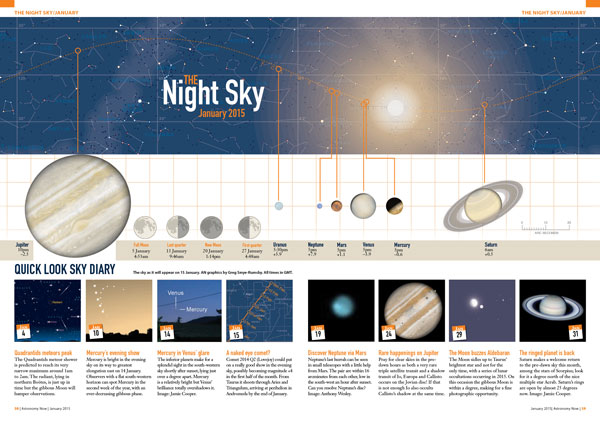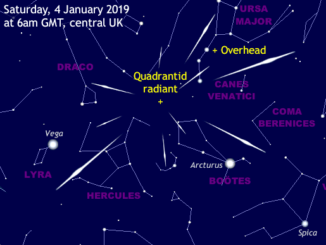
The Quadrantids are predicted to peak in the hours between midnight and 2 am GMT, with a short, sharp maximum, with best activity confined to a six-hour period within their normal limits of 1st-6th January. There is quite a wide disparity in the quoted zenithal hourly rate (ZHR) — the probable number of meteors observed per hour from a shower having its radiant at the zenith — with figures as high as 120 or as low as 60. As the evening wears on the radiant will steadily climb to be 30° or so up in the north-east at midnight.
From North America the peak will occur around 9 pm EST, but at that time the radiant is very low on the northern horizon. The best bet is to observe the shower between midnight and 2 am when the radiant is around 30° above the north-eastern horizon (New York latitudes). As the radiant steadily rises this helps the meteors visibility over a bigger area of sky, albeit with rates declining in theory as the predicted maximum passes. Nevertheless, one can never be 100 percent accurate when predicting any meteor shower, so it’s well worth staying up for as long as possible; at least you can have a lie-in on Sunday morning!
The radiant lies in northern Boötes, east of Alkaid (eta Ursae Majoris), at the end of the Plough’s handle near the shared border with Draco and is circumpolar from the UK. The reason why the shower is named the Quadrantids is that this area of the sky used to be known as Quadrans Muralis, a now defunct constellation covering the area between the right foot of Hercules, the left hand of Boötes, and Draco. It was introduced in 1795 by J. Fortin, maker of globes and spheres for the French royal family. The figure represented the mural quadrant of Joseph Jérôme de Lalande, the eighteen century French astronomer who charted 50,000 stars with the quadrant while at the collège de France. He took his inspiration from his countryman Nicolas Louis de Lacaille, who charted the southern skies some years earlier, inventing many of the southern constellations still in use today.
Quadrantids meteors are slow to medium speed, around 43 kilometres/second, compared with 35 km/s for Geminids and 71 km/s for Leonids. Around 10 percent leave a persistent, glowing trail or train, with the brighter ones often appearing blue and yellow. Like the Geminids, the shower appears to be produced from the debris of an asteroid (2003 EH1), possibly the extinct nucleus of a comet that broke up centuries ago.
Inside the magazine
Find out more about what’s up in the night sky in the January edition of Astronomy Now. Never miss an issue by subscribing to the UK’s biggest astronomy magazine. Also available for iPad/iPhone and Android devices.




